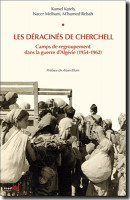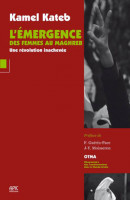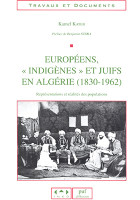
Les déracinés de Cherchell
Camps de regroupement dans la guerre d'Algérie (1954-1962)
Collection : Études et enquêtes historiques
2018, 200 pagesPreface, Alain Blum
General Introduction
Chapter 1. Regrouping the populace: an anti-guerrilla strategy
I. “Population regroupment centres” (CRPs) and prohibited areas
II. A general overview of the CRPs
III. The ALN [Army of national liberation] in the foothills of Cherchell: the first clashes
IV. CRPs in the Cherchell region
Chapter 2. Rural life as lived between traditions and the colonial administration
I. A population made up of Berber-speaking tribes
II. The disappearance of an ancestral tribal society
III. Memories of a rural life
IV. Relations with the colonial administration
Chapter 3. Expulsion, uprooting, dispossession
I. A military imperative
II. The violence of the expulsions
III. Rough living in the camps
Chapter 4. Life in the camps: the view from both sides
I. Military perceptions of life in the camps
II. The camps as seen by the “regrouped”: barbed wire and watchtowers
Chapter 5. Vulnerable population groups
I. The situation of women in the camps
II. From shepherd to pupil: children in the torment of the war
III. Working outside the regroupment centre
Chapter 6. The end of the war
I. The failure of the anti-guerrilla strategy
II. Revolt
III. “All Frenchmen are not of the same seed”
IV. The harkis
Chapter 7. Afterwards
I. Post-war disappointments
II. The difficulty of reintegrating regroupment centre populations
III. A definitive change from the world that was
Chapter 8. Residential trajectories and migrations
I. Forced residential mobility
II. From sedentary life to mobility
Chapter 9. Portraits of the “regrouped” and their diverse fates and fortunes
I. Major life changes
II. Those who remained
III. New futures
IV. Singular figures and multiple trajectories
General conclusion
Bibliography
Appendices
[The uprooted people of Cherchell: regroupment camps during the Algerian War (1954-1962)]
From 1954 to 1962, one-fourth of the population was displaced by the French military authorities and confined in regroupment camps in order to destroy what they presumed to be a source of support for the armed independence fighters.
Cut off from their lands and means of subsistence, these relatively poor groups composed primarily of women, children and older persons had to create new lives for themselves in these makeshift camps.
The forced moves radically changed the living conditions of thousands of Algerian peasants, and the effects were felt well beyond the period of confinement.
The book reconstitutes the trajectory of persons from the region of Cherchell who underwent forced displacement and presents their accounts, thereby making a fundamental contribution to the reconstruction of an often forgotten or obliterated episode in collective memory.
Collectively swept up in the turmoil and shock of the war, these men and women attest to a wide range of different life paths. The authors collected the detailed stories of their broken trajectories. In a few cases, the painful experience of being uprooted opened the way to relatively satisfactory outcomes.
Kamel Kateb is an INED demographer and researcher in the “International Migrations and Minorities” and “Identities and Territories” research teams. He studies Algerian history through statistics, the history and educational systems of specific groups in North African countries, and migration between the Maghreb and Europe.
Nacer Melhani is a trained, practicing agronomist interested in the development of rural populations in the Cherchell region. He is involved in community associations and movements and has written several press articles (in French and Arabic) on Algerian history.
M’hamed Rebah is a writer interested in questions of the environment and topics concerning the media, history and current events. Though retired, he continues to be active in community associations and movements.



